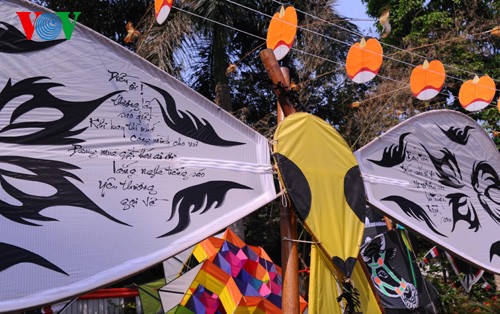(VOVworld) – 300 years ago, kite flying was an indispensable part of the Royal festivals and new year celebration of the Nguyen dynasty. Kite flying in the imperial city of Hue has been preserved and developed as an archetypal art of the people of Hue. To make their colorful and sophisticated kites requires great skill on the part of the artists.
 |
The northern region of Vietnam has typical flute kites, where the sound of the flute resounds when the kite flies up to the sky. The southern region is famous for its aerodynamic kites. Meanwhile, traditional Hue kites are the famous brand name in the central region. It is said that Hue kite flying is a kind of in-air puppetry art, as many folk legends are portrayed on the kites - such as Tam Cam and Son Tinh Thuy Tinh. To create such sophisticated and lively puppetry requires skillful artists who have a lot of experience in kite making. Nguyen Van Hoang is one of the two recognized craftsmen of traditional Hue kites in Thua Thien Hue province. He said this craft has been handed down through 4 generations in his family.
Hoang said the Hue kites are divided into 3 types: preliminary, traditional and modern kites. Traditional Hue kites must be made in the style typical to Hue. In the skillful hands of Hue artists, thousands of kites of the different sizes and shapes of dragons, eagles, phoenixes, butterflies and goldfish have been created. Hoang said: "Because Hue was the imperial citadel, Hue kites often depict royal symbols such as dragons, phoenixes and butterflies. The decorative patterns are symbolized on kites. The major motifs are animals".
Although the kites are big, they are still able to be controlled to fly with the wind. Each kite is considered a work of art which is imbued with the experience, knowledge, ideas and creative sense of the artist. There are a number of steps to create a Hue kite. First is selecting the bamboo. The bamboo is then dried until they turn yellowish, ready to make the kite frame. The bamboo is sharpened into thin and flexible laths then glued and covered with thin cloth. Finally, the creator decorate the kites. It takes at least 3 to 5 days to make a kite: "The most important thing is to make the shape of the kite. You need to take into consideration the balance, the proportions of the kite’s parts, especially the kite’s frame, then its decoration. It is essential to define the central point of the kite to tie to help it fly at a good height".
Hue kites are highly valued as they are made by hand. The price of these kites range from 500,000 VND to several million VND. More and more foreigners are keen to order and purchase Hue kites. Artist Hoang again: "Dragon kites are assembled like a train. The head of the dragon together with the body and tail are decorative. The body of dragon kite flies freely in the air. It takes around 1 month to make a dragon kite and requires care and accuracy".
In the art of Hue kite making, dragon and phoenix kites are considered among the finest forms of kite making in Vietnam and the world. Dragon kites are nearly 150 meters long, and the 240 meter phoenix kite can weigh more than 7 kilograms. It takes nearly 2 months to complete those kites. They have taken part in a number of domestic and international festivals, such as the Asia Kite Festival in Thailand, the Reunion island kite festival in Africa, and the International Kite Festival in Canada.
Kites of many different patterns and styles can be seen at Hue’s Ngo Mon square. Nguyen Duc Mau is a Hue local: "The childhood of Hue’s people is closely attached to those kites. Kites are often flown in big fields in rural areas. In big cities, children fly kites in the parks. Our kites, depicting different kinds of animals, make Hue’s sky more interesting".
For every citizen of Hue, kites are part of their lives. They have become a unique cultural feature of the ancient capital city.